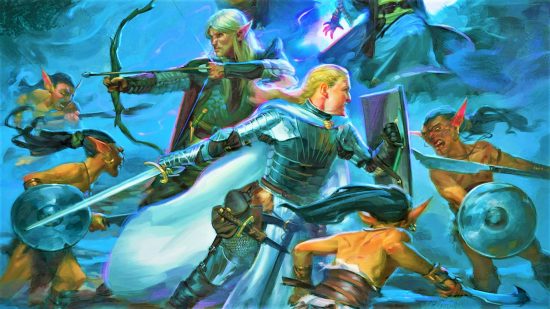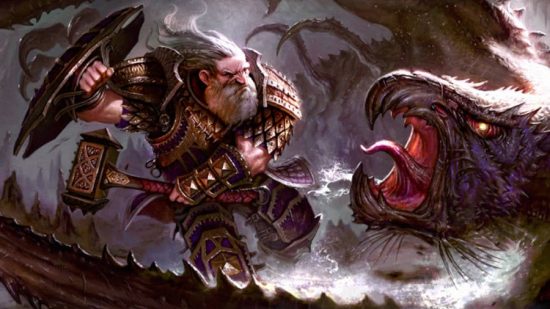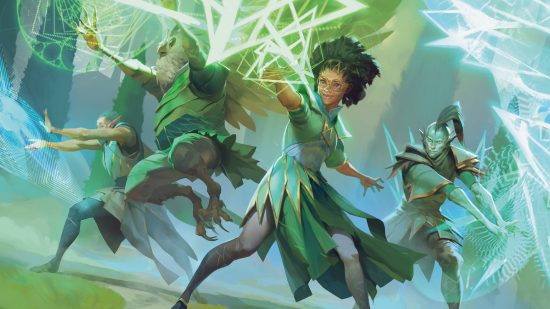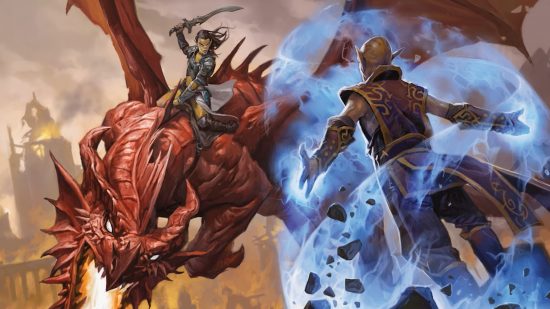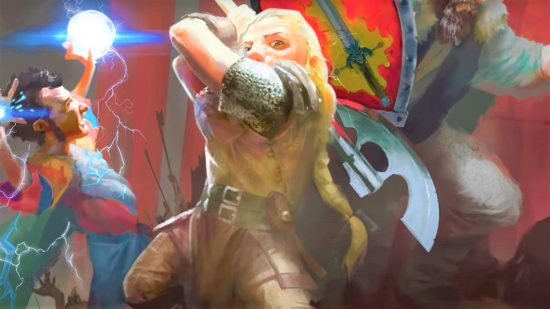Every Dungeons and Dragons player will be familiar with the phrase ‘roll for Initiative’. However, if you’re new to fifth edition, it might not be immediately obvious how the DnD Initiative 5e rules work. Sure, you’re about to charge into battle, but what do you need to roll to make that happen? We’re here to explain how to set up a DnD Initiative tracker.
Initiative doesn’t discriminate, so it works the same for all players, regardless of what DnD classes and DnD races you wrote down on your 5e character sheet. All you need is some basic knowledge about how to play Dungeons and Dragons – and maybe the most important DnD books on hand.
Here’s everything you need to know about the DnD Initiative 5e rules:
- What is DnD Initiative?
- How to calculate DnD Initiative
- DnD Initiative tips for DMs
- Resolving tied DnD Initiative rolls
- Running DnD Initiative with large groups of enemies
- Joining the DnD Initiative order late
- How to increase DnD Initiative rolls
- Alternative DnD Initiative rules
What is DnD Initiative?
According to chapter nine of the Player’s Handbook, “Initiative determines the order of turns during combat”. Before a fight begins, all players must make a Dexterity roll. The Dungeon Master will do the same for the enemies that the party will face.
Once everyone has rolled, the Dungeon Master will note the order of these results, from highest to lowest. If you rolled higher than everyone else, congratulations – you’ll get to take your turn first!
How to calculate DnD Initiative
What is ‘a Dexterity roll’, exactly? The answer is pretty simple. Roll a d20, and add your ability score modifier for the Dexterity DnD stat.
You can find your Dexterity modifier on the left-hand side of your character sheet. To make life even easier, many character sheets also have a separate ‘Initiative’ box that shows the number you’ll need to roll.
DnD Initiative tips for DMs
While DnD players only need to manage their own Initiative, the Dungeon Master must facilitate combat for everyone. This is a slightly taller order, so we’ve put together some key bits of advice for tracking Initiative:
Know when to call for Initiative
Just because the party shares a scene with some hostile DnD monsters, it doesn’t mean you need to roll Initiative straight away. Perhaps your Big Bad Evil Boss wants to make a long, patronizing speech before attacking the heroes. Or maybe the characters with good DnD alignments want to try some peaceful conflict resolution first. The call for Initiative comes the moment that a fight is guaranteed.
In many cases, this moment will be obvious. The peace talks will go awry, and swords will be readied. Or the enemy will rush forward, screaming bloody murder. But that’s not always what the Initiative trigger looks like.
For example, the party might be hunting a particular enemy, and they’ve managed to Stealth their way into combat range. If the players decide they’re going to perform an ambush, you roll Initiative, regardless of whether the NPC knows the ambush is coming or not.
In this instance, the Dungeon Master will also ask the player-characters to roll an additional Stealth check. If they beat their foe’s passive Perception score, the enemy is Surprised. This means they can’t move or act on their first turn in combat, even if they rolled higher in the Initiative order.
Clearly note the Initiative order
Every DM has a different way of noting the Initiative order, but you should make sure it’s clear and easy to understand. You might find it helpful to use Initiative tracker tools – for example, a whiteboard or magnets that attach to your DM screen. If you’re playing on a virtual tabletop like Roll20, an automated Initiative tracker will likely be available.
You don’t have to display your Initiative order for everyone to see, but there’s also no reason to keep turn order a secret from your players. So feel free to write Initiative down in a place where your players can see it, too.
Remind everyone when their turn is coming up
In a perfect world, your players will be planning their turn while everyone else is acting in combat. Then, they’ll start their turn knowing exactly what they want to do.
This is the ideal, but sometimes plans go astray. If your players can’t see the Initiative order or are struggling to remember when their turn is, give them a gentle reminder. When you announce the player turn before theirs, remind them that they’ll be in the spotlight very soon.
Keep up the roleplay
Combat is the crunchiest part of a Dungeons and Dragons game, and it can be easy to forget about the roleplaying side of things. As Dungeon Master, it’s up to you to keep the storytelling going.
Encourage players to describe what their 5e spells and DnD weapon attacks look like. If they destroy an enemy, give them control over what the killing blow looks like.
When players are incapacitated or can’t act on their turn, ask them what their character is thinking about in their moment of weakness. And when the DnD death saves start, make sure they’re suitably dramatic. Even if a player can’t take actions, they should still get the chance to play.
And on your end, make the monster attacks sound suitably epic. Detail is your friend (though be sure to check how squeamish your players are before describing each wound).
Resolving tied DnD Initiative rolls
It’s going to happen to you – two players will roll the same on Initiative. Luckily, the Player’s Handbook has a plan in place for ties.
The Dungeon Master decides the order of Initiative for any tied creatures they control. If more than one player gets a tied roll, the players decide who acts in what order. If players tie with monsters, it’s the DM’s call who gets to go first. The DM can also instead choose to have tied characters roll a d20, with the highest rolls determining the Initiative order.
There’s also another unofficial way. If you like, you can check the Dexterity score of all creatures stuck in a tie. Resolve the tie from first to last based on who has the highest Dexterity score. If these are tied too, go back to the original tie-breaker method.
Running DnD Initiative with large groups of enemies
The Player’s Handbook states that “The DM makes one roll for an entire group of identical creatures, so each member of the group acts at the same time”. Many DMs choose to bend this rule a little, as having five or six monsters attack at the same time can feel a little unbalanced.
If the monsters roll well for Initiative, they’ll be a brutal force in the early rounds. On the other hand, a poor roll might mean they’re all wiped out before you get a turn in. If you’re keen to spread things out, group large numbers of enemies into smaller groups, and have them each make a different Initiative roll.
This works pretty well for reasonably sized groups of enemies. But what if your party is facing 50 Kobolds at the same time? That could get a little chaotic, even if you split them into groups. In these cases, we recommend using Wizards of the Coast’s playtest rules for Mass Combat.
Joining the DnD Initiative order late
If half your party were in another room when the fight broke out, they’ll need to rush in before they can start swinging. Or if the town guard has called for reinforcements, they might not arrive for a few rounds.
There are no official rules in the Player’s Handbook that say what to do if a character joins combat late. But if you need to plan for latecomers, we recommend having them roll their Initiative as usual. When the next round of combat begins after their arrival, slot them into the Initiative order based on that roll.
How to increase DnD Initiative rolls
Having a high Dexterity score is the easiest way to make better Initiative rolls. However, there are a few extra character options that can improve your chances:
- Take the Alert 5e feat – This gives you an automatic +5 to Initiative rolls.
- Cast Guidance – This DnD cantrip adds 1d4 to any ability check, including an Initiative roll.
- Find the right DnD magic items – A variety of magic items give you advantage on Initiative rolls, e.g. the Sentinel Shield or the Weapon of Warning.
- Play a DnD Harengon – Their Hare-Trigger feature lets you add your proficiency bonus to Initiative rolls.
- Play a DnD Bard – From level two, Bards can use their Jack of All Trades feature to add half their proficiency bonus to Initiative rolls.
- Play a DnD Barbarian – All Barbarians get advantage on Initiative rolls at level seven.
- Play a DnD Gloom Stalker – Their level-three Dread Ambusher feature adds their Wisdom modifier to Initiative rolls.
- Play a Divination Wizard – The Portent dice you roll at the start of each day can be used to change the results of your Initiative roll.
Alternative DnD Initiative rules
The Dungeon Master’s Guide includes several suggestions for alternative DnD Initiative rules. These include:
Passive Initiative
Instead of rolling, every participant gets a Passive Dexterity score that determines their Initiative. This is 10 plus their Dexterity modifier. This massively simplifies Initiative tracking, but you’ll have roughly the same Initiative order every time.
Side Initiative
The players roll 1d20 with no modifiers, and the Dungeon Master does the same. The ‘side’ that rolls highest gets to act first in combat, and each individual can act in any order.
Roll Initiative at the start of every round
If you want things to be more dynamic, try rolling a new Initiative order at the start of every round. The DM’s Guide also suggests using ‘Speed Factor’ modifiers to determine who’s likely to act first in a fight. For example, you’d subtract the level of a spell a DnD Wizard just cast from their Initiative roll. And creatures of smaller DnD sizes will be speedier than larger ones.
This is by far the most complex way to run Initiative, so make sure you have the DM’s guide handy if you want to try this method.
For more rules explainers, here’s how to do a DnD level up. We can also explain how DnD Disengage and DnD Opportunity Attacks work.

